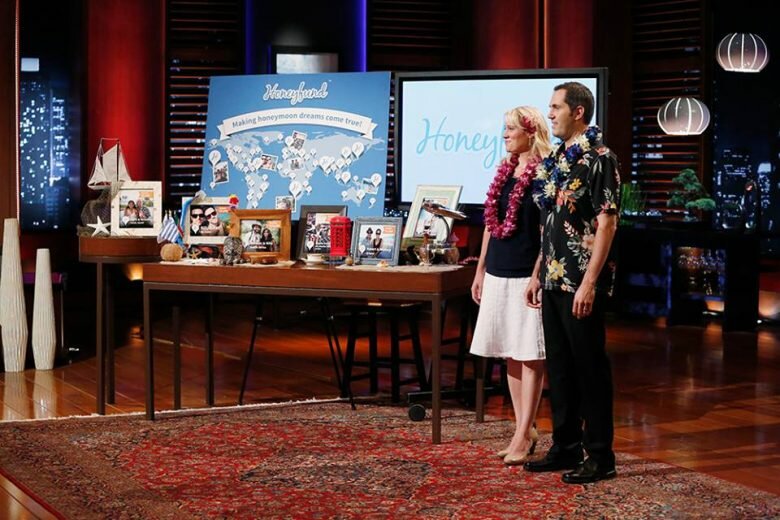The Basics
- Company: Honeyfund
- Owner: Sara and Josh Margulis
- Product: Honeymoon registry service
- Asking Price: $400,000 for 10% equity
- Final Deal: $400,000 for 33% transaction revenue until 3x investment recouped
- Shark Who Took The Bait: Kevin O’Leary
- Season/Episode: Season 6, Episode 6
Honeyfund Before Shark Tank
Josh and Sara Margulis are a beautiful married couple from Sebastopol, California (aka Sonoma wine country) who founded Honeyfund, the free honeymoon gift registry.
Both aspiring entrepreneurs when they met, they founded the Honeyfund site to fund their own wedding and honeymoon, originally – but when they saw how successful it was and how much their wedding guests raved about the idea, they knew they had hit on something big.
Honeyfund On Shark Tank: A Quick Recap
Josh and Sara take the stage dressed like – you guessed it – a newlywed couple on their honeymoon, replete with Hawaiian t-shirts and flower leis around their necks. They look sun-kissed and glowing, and confident enough to ask for $400,000 in exchange for 10% equity in their company, Honeyfund.
The idea behind Honeyfund is brilliant and long overdue: a free, unique wedding registry where couples can raise funds for their dream honeymoon, using donations as wedding gifts. Their entire honeymoon, essentially, becomes their wedding gift, which is collectively paid for by individual guests. “We call this process crowd-gifting,” says Sara, and the sharks look highly impressed.
“Would you rather have a set of China, or a trip to China?”
Instead of traditional samples, Sara and Josh pass out flower leis and Mai Tais in cutesy Tikki bar coconut cups.

Somebody take away Kevin’s Mai Tai before he gets belligerent.
Running the Numbers
“We’d like to propose a toast!” The sharks and contestants all raise their coconut cups in a toast to cash flow, as the show heads into the numbers segment.
- Fundraising totals: $200 million
- Revenue streams: Paypal transaction fees
- Annual sales: $67 million in transactions
- Income from annual sales: $987,000
- Profit from annual sales: $219,000
Kevin points out here that this business raises the essential, age-old question of customer-acquisition cost (CAC). Sara explains that every wedding registry account invites an average of 150 wedding guests, so their exposure and brand visibility automatically expands with each new registered couple. On average, she says, their customer acquisition cost is $0.88 cents per customer, and their average value per customer is $9.
These numbers might sound great to the layman, but Mark Cuban is skeptical.
As Cuban explains, putting half a million dollars in the bank for themselves, as a couple, is phenomenal. But it’s not necessarily investable. He wants to know what the long-term plan is and how they intend to grow. “Because, to be honest, to be in business ten years and do $987,000 in gross revenue is horrible.”
“It’s been a lifestyle business up to this point, but of course – we’re here because there’s more,” says Sara.
People eventually began using honeyfund for things other than weddings and honeymoons. The couple took this idea and ran with it, creating Plumfund. Plumfund lets users crowdfund anything, online, for free.
“Hang on,” says Robert. “So…your answer to expanding Honeyfund…is to do…another fund?”
“Our answer is to do a whole portfolio of funds,” says Sara, with a click of the television display – revealing an entire family of other crowdsourced websites.
“Ugh,” says Cuban, clearly disgusted with the expansion concept.

Sara and Josh, unruffled by Cuban’s criticism.
As the camera pans to the display, we can see an array of future funds or fund concepts, including:
- Anniversary Fund
- Birthday Fund
- Baby Fund
- Grad Fund
- Mazel Fund
Kevin digits into Plum Fund a little deeper to get an idea of the likelihood of success for these other, future funds. Over the course of 12 months, Plum Fund has generated $400,000 in transaction sales and $10,000 in revenue.
When the sharks say that it’s clearly a great idea but that they’re not totally sold, Sara takes the presentation in yet another direction. “I’ve got another idea,” she says, and a new slide appears on the television display. “Fondo de Miel.” (That’s Spanish for Honeyfund.) “There are 53 million Spanish speakers in the United States alone,’ she says. This could double our business over the next few years.
The Bidding
Lori is first to drop out, though she praises their idea to expand into other countries and capture the Spanish-speaking market. “I think crowdfunding is crowded. For that reason, I’m out.”
Kevin seems interested, but it still obviously skeptical. “If I fund you today, how do I get my $400,000 back?” Sara responds that they’re planning on scaling the business quickly, over five years, and come to dominate the crowd-gifting space.
“Guys, just what you said right there, does not make sense,” interjects Cuban. “There’s no such thing as scaling quickly over five years. By bringing in all these other options, you’re saying you’re not dominating the space you’re supposedly already dominating.”
“We already do dominate this space – we have 30% market share in this space.”
“You’ve got a nice little business, and again, bravo,” says Cuban. “But when a business starts looking everywhere else, it suggests to me that it’s on autopilot. If it was growing so fast, and becoming so profitable, you’d be telling us you need this capital just to keep up with it. But that’s not what’s happening here. For that reason, I’m out.” And with that, Cuban is out.
After Cuban and Lori drop out, the Honeyfunders receive three offers in rapid succession from the other sharks.
First, Robert Herjavec offers $500,000 for 50% equity. He says they’ve done a phenomenal job creating transaction value, and that transaction value is where they should focus (not on brand extensions).
Next, Kevin proposes a more complex, “Mr. Wonderful”-style deal: $400,000 with no equity interest in return for one-third of their transaction revenue until he recoups $1.2 million (or three times his original investment).
Last, Barb Shark jumps in to undercut Robert, offering $400,000 for 30% equity. Robert quickly tries to match her, but to no avail.
After running the numbers on stage, Sara and Josh agree to Kevin’s terms.
Final Deal: $400,000 for 1/3 transaction revenue until $1.2 million recouped
Honeyfund After Shark Tank: Where Are They Now?
So just how successful was this appearance, and what has Honeyfund been up to lately? Well, let’s start with the immediate repercussion of this episode. On the night that Honeyfund debuted on Shark Tank, their average daily visitor count skyrocketed from 150 to 5,000.
That growth has since leveled out, but the company still sees an average of 45% more web traffic than they did prior to their appearance on Shark Tank.
Since their appearance on Shark Tank, they’ve processed $514 million in gifts. They’ve branched out into travel giftcards and are partnering with retailers to create universal gift registries, so that travel or experiential packages are no longer the only thing a wedding guest can fund via someone’s Honeyfund page.
While their other sites they envisioned – the various ‘funds’ like Babyfund and Gradfund, etc – have all been umbrellaed under Plumfund, which has sextupled in size since the couple appeared on Shark Tank.
And of course, since every true success story is now reflected and amplified through social media, it goes almost without saying that the Honeyfund Instagram account is massively popular, with more than 5,000 followers, while the Honeyfund Facebook page boasts more than 24,000 fans and followers.
They’ve received glowing writeups in The New York Times, Vogue, BRIDE magazine, and countless other media outlets.
In short, Honeyfund was a smashing success, and their appearance on Shark Tank was one of the best decisions they’ve ever made. Years of hard work and months of rehearsing their presentation paid off more than the couple ever imagined.
For Honeyfund, it seems, dreams really do come true.
Disclaimer: The information provided in this article is strictly informational; Seo Insights is not affiliated with Honeyfund, SharkTank, or any of its subsidiaries.
